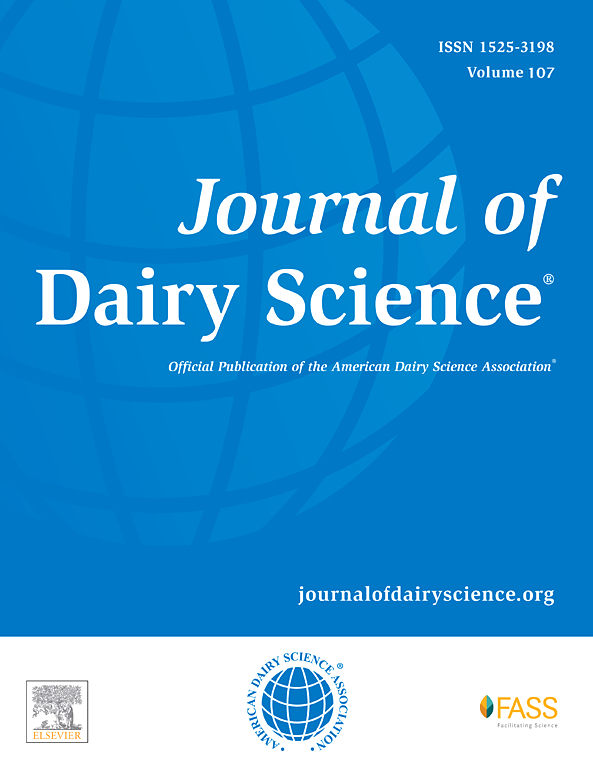A randomized controlled trial to evaluate the effect of 2 hoof trimming methods at dry-off on hoof lesion and lameness occurrence in dairy cattle
IF 3.7
1区 农林科学
Q1 AGRICULTURE, DAIRY & ANIMAL SCIENCE
引用次数: 0
Abstract
Despite hoof trimming (HT) being a recommended procedure for hoof lesion and lameness prevention, there is limited data on the efficacy of different HT methods. Our objective was to compare the effects of HT cows at dry-off with the functional method that uses a little model (LIT) to an adaptation with bigger modeling (BIGM) of the higher load-bearing hoof on the occurrence of new hoof lesions and the risk for lameness in the next lactation. Cows scheduled for their regular HT at dry-off were enrolled weekly from 3 sand-bedded freestall housed herds located in Wisconsin (n = 2) and Minnesota (n = 1). Cows were eligible for enrollment if they did not have hoof horn lesions at their dry-off HT. Cows were allocated to either LIT or BIGM weekly. Locomotion scores were collected on a biweekly basis from 2 herds, once before enrollment and until their subsequent HT or up to 165 DIM. Two trained hoof trimmers collected hoof lesion data either during the cow's scheduled midlactation HT between 100 and 165 DIM or during an HT prompted by identification as a lame cow by farm personnel. Data were analyzed using multivariable logistic regression, with the presence of any hoof lesion as the outcome of interest and multivariable Cox proportional hazards models, with the presence of lameness as the outcome of interest. A total of 1,556 cows were enrolled, with 790 (51%) cows in the LIT treatment and 766 (49%) cows in the BIGM treatment. The average DIM at the cow's next HT was 113 (95% CI: 111–114 DIM). A total of 205 (16.2%) of 1,265 cows were identified with a lesion before 165 DIM. A total of 501 (43%) of 1,167 cows were identified as lame following enrollment. There was no evidence of a difference between the LIT and BIGM groups overall when presence of any hoof lesion was considered as the outcome. The median time to lameness was 193 d for LIT and 203 d for BIGM. For the hazard of lameness outcome there was no evidence of a difference between the LIT and BIGM groups overall. However, for both the presence of any hoof lesion and lameness outcomes, a cow's lactation group modified the effect of BIGM. First-lactation cows trimmed with BIGM had reduced risk of any hoof lesion and specifically reduced risk for hoof horn lesions (risk difference 6.1%, 95% CI: 9.6%–2.5%) and odds 76% (odds ratio 0.24, 95% CI: 0.10%–0.58%). In addition, first-lactation cows and cows with an enrollment locomotion score <3 had a lower hazard of becoming lame in the following lactation if they were allocated to the BIGM treatment, compared with cows trimmed with LIT. In summary, the effect of the BIGM trimming method was modified by factors related to parity and prior lameness status, possibly influenced by bone exostosis on the third phalanx. Therefore, the BIGM HT method should be considered to prevent lameness and hoof lesions when animals are trimmed at their first-lactation dry-off trim.
通过随机对照试验,评价两种割蹄方式对奶牛蹄损和跛行的影响。
尽管蹄子修剪(HT)是一种推荐的治疗蹄子病变和跛行预防的方法,但不同方法的疗效数据有限。我们的目的是比较HT奶牛在干乳时,使用小模型(LIT)和使用大模型(BIGM)适应高负荷蹄的功能方法对新蹄病变的发生和下次泌乳时跛行风险的影响。每周从位于威斯康辛州(n = 2)和明尼苏达州(n = 1)的3个沙床自由栏饲养的牛群中招募计划在干燥期进行常规高温疗法的奶牛。如果奶牛在干燥期没有蹄角病变,则符合入组条件。每周将奶牛分配到LIT或BIGM组。研究人员每两周收集2头奶牛的运动评分,一次是在入组前,一次是在随后的HT或165 DIM时。两名训练过的蹄修剪员在奶牛预定的哺乳期中期HT期间(100 - 165 DIM)或在农场工作人员识别为跛牛的HT期间收集蹄损伤数据。数据分析采用多变量逻辑回归,以蹄部病变的存在作为关注的结果;采用多变量Cox比例风险模型,以跛行作为关注的结果。共入组1556头奶牛,其中LIT组790头(51%),BIGM组766头(49%)。奶牛下一次HT的平均DIM为113 (95% CI: 111-114)。1265头奶牛中有205头(16.2%)在165头DIM之前被鉴定为病变。1167头奶牛中有501头(43%)在入组后被鉴定为跛行。当将任何蹄部病变视为结果时,没有证据表明LIT组和BIGM组之间存在差异。到跛行的中位时间,LIT为193 d, BIGM为203 d。对于跛行结局的危险,总体上没有证据表明LIT组和BIGM组之间存在差异。然而,对于任何蹄损伤和跛行结果的存在,奶牛哺乳期组修改了BIGM的效果。第一次用BIGM修剪的泌乳奶牛降低了任何蹄部病变的风险,特别是降低了蹄角病变的风险(风险差异为6.1% (95% CI: 9.6 - 2.5),优势为76% (OR 0.24, 95% CI: 0.10 - 0.58)。此外,首次泌乳奶牛和入组运动评分< 3的奶牛在接下来的泌乳中跛行风险较低,与LIT修剪奶牛相比。综上所述,BIGM修剪方法的效果受到胎次和先前跛行状况相关因素的影响,可能受P3骨外生的影响。因此,应考虑采用BIGM HT方法,以防止动物在第一次哺乳期干切时发生跛行和蹄损。
本文章由计算机程序翻译,如有差异,请以英文原文为准。
求助全文
约1分钟内获得全文
求助全文
来源期刊

Journal of Dairy Science
农林科学-奶制品与动物科学
CiteScore
7.90
自引率
17.10%
发文量
784
审稿时长
4.2 months
期刊介绍:
The official journal of the American Dairy Science Association®, Journal of Dairy Science® (JDS) is the leading peer-reviewed general dairy research journal in the world. JDS readers represent education, industry, and government agencies in more than 70 countries with interests in biochemistry, breeding, economics, engineering, environment, food science, genetics, microbiology, nutrition, pathology, physiology, processing, public health, quality assurance, and sanitation.
 求助内容:
求助内容: 应助结果提醒方式:
应助结果提醒方式:


